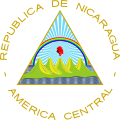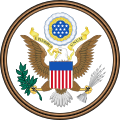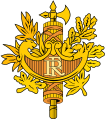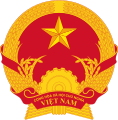National coat of arms
A national coat of arms is a national emblem that symbolizes a state . In contrast to state flags , which are mainly used as flags , a state coat of arms serves as a symbol of the state in the form of a coat of arms , seal , badge and the like, mainly on print media or plaques. It is not uncommon for state coats of arms to appear on the official flags of state authorities and armed forces, as well as standards of heads of state.
Types of national coats of arms
Heraldic coat of arms
The oldest national coats of arms in Europe are coats of arms in the heraldic sense, that is, in their center is the symbolic representation of the state on a shield, which is supported by various other symbols, e.g. B. shield holder , helmet ornament or banners, can be accompanied. Their origin lies in the shields of medieval knighthood .
State seal
Another design type is that of the state seal. Seals were originally used for the certified, unfalsifiable closure of documents or letters and were often stamped in wax or similar materials. A seal is very often circular and rarely more than one color. It can contain a coat of arms. State coats of arms that are based on seals are often colored versions of this single-colored seal.
State emblem
This designation can include any other national emblem that cannot be assigned to any of the types mentioned above. A state emblem can be designed like a plaque or represent any state symbol without a fixed form.
East Asian emblems
The Japanese counterpart to a coat of arms is the Mon (Japanese 紋 , "sign" or "emblem"), which is comparable to the coat of arms in heraldic usage in the western world. Most Mon are monochrome and show the stylized representation of a plant or an animal in an outlined circle. The coats of arms of other East Asian states are designed in a similar manner. The coats of arms of the People's Republic of China (Hong Kong and Macau) and Vietnam combine the circular shape with socialist coat of arms motifs.
National coat of arms of socialist type
Based on the model of the coat of arms of the USSR , many national coats of arms were designed in the second half of the 20th century . They regularly consist of an almost circular image that often includes landscape forms ( mountains , valleys , waters ) and almost always a rising sun and a five-pointed star , often combined with an emblem of progress, work or battle symbols ( cog , various tools or Weapons ), surrounded by a wreath of floral elements, on which a banner with the national motto is attached. Many of these coats of arms were replaced by heraldic, mostly older, ones after the collapse of the communist Soviet Union in the 1990s. The coat of arms of 1948 of non-communist Italy still exists today; The coat of arms of Nepal , which was introduced after the end of the Nepalese civil war between the monarchical state and the communist party in 2006 and is intended to reflect the new unity in the country, is also designed according to this pattern.
State coat of arms of the Soviet Union (comparable: member states of the USSR )



















